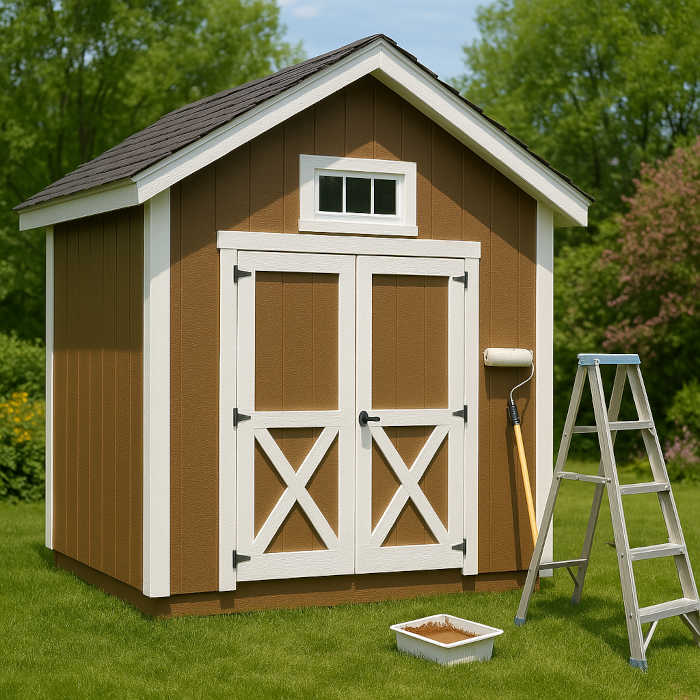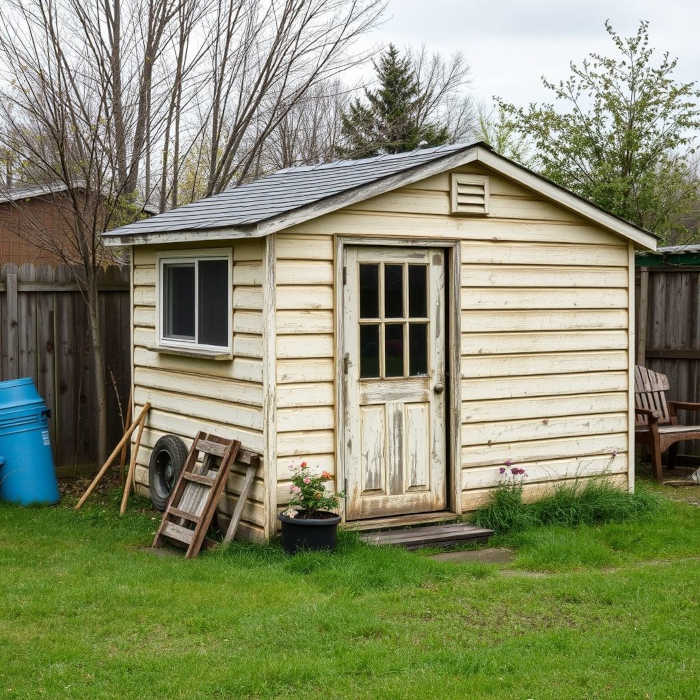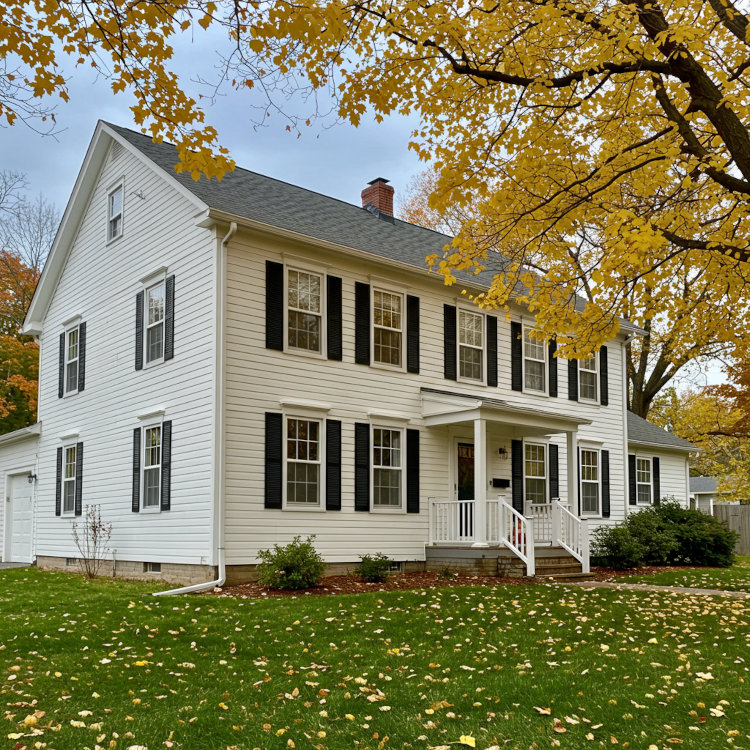As an Amazon Associate, I earn from qualifying purchases. Privacy Policy / Terms
Spring is here! The air is fresh, the birds are singing, and your yard is coming back to life. But if you’re like me, you’ve noticed that your backyard shed is looking a little tired after a long winter. A fresh coat of paint would give it the facelift it needs—just in time for sunny days and summer barbecues. Now is the perfect time to tackle this project since mild temperatures help the paint cure properly and ensure a lasting finish.
But let’s be real: spring can be a tricky beast. One minute the sun’s shining, the next, a surprise rain shower shows up uninvited. And don’t even get me started on the pollen. If you’re not careful, you could end up with a shed that’s not only freshly painted but also beautifully decorated with a layer of yellow dust.
So, how do you conquer these springtime challenges? I’ve got you covered with a game plan to ensure your shed looks like it was painted by a pro—minus the pollen art and unexpected rain splatters.
Timing is Everything: Pick the Perfect Spring Day
When it comes to painting in spring, checking the weather is non-negotiable. Sure, spring has some beautiful days, but it also loves to throw in a curveball. Here’s how to pick the best time:
Aim for Low Humidity Days: Ideally, you want the humidity to be below 50%. High humidity slows down drying time and can cause the paint to take forever to cure, leaving it vulnerable to dirt, dust, and pollen.
Temperature Sweet Spot: Paint performs best when temperatures are between 50°F and 85°F. Too cold, and the paint won’t adhere properly. Too hot, and it dries too quickly, leading to cracks and uneven finishes.
Avoid Windy Days: Wind is a double whammy—it speeds up drying (which you don’t want) and can blow dust and pollen right onto your wet paint. No one wants that textured look!
Pro Tip: Check the 3-day forecast and aim for a window where you’ll have at least 24-48 hours of dry, mild weather. That gives your paint time to dry without interference from Mother Nature.
Prep Like a Pro: Don’t Skip These Steps
Prepping is the unsung hero of any good paint job. If you skip it, even the best paint won’t save you from peeling, chipping, and uneven finishes.
Clean the Surface Thoroughly: Sheds collect dirt, mildew, and pollen over the winter. Use a pressure washer or a hose with a stiff-bristle brush to scrub off grime. A solution of water and mild detergent works wonders.
Sand and Scrape Where Needed: Got old, flaky paint? Scrape it off and sand the surface smooth. This gives your new paint a solid surface to adhere to.
Prime Time: If your shed’s paint is faded or the wood is bare, a good primer helps the new coat stick and last longer. Use a high-quality exterior primer that’s resistant to mildew and moisture.
Pro Tip: Don’t paint right after you wash the shed. Give it at least a full day to dry to avoid trapping moisture under the paint.
The Pollen Problem: How to Keep It Off Your Fresh Paint
Spring and pollen go together like peanut butter and jelly—except no one invited the pollen. If you’re painting while pollen is flying around, it can land on your wet paint and create a bumpy, textured surface that’s impossible to fix. Here’s how to sidestep that headache:
Check Pollen Counts: Most weather apps now include a pollen forecast. Aim to paint on days when the pollen count is low. Mornings are usually better, as pollen levels tend to spike in the afternoon.
Cover Your Shed Between Coats: If you’re doing multiple coats (which you should for durability), cover the shed with a lightweight tarp or plastic sheeting while the paint is drying to keep pollen off.
Use a Tack Cloth: Once the paint is dry but before adding the next coat, lightly wipe down the surface with a tack cloth to pick up any stray particles.
Beating the Rain: The Art of Dodging Spring Showers
Spring rain is as unpredictable as a toddler’s mood. It can go from sunny to stormy in minutes, and fresh paint + surprise rain = disaster. Here’s how to outsmart the clouds:
Paint Early in the Day: Morning is your best friend. It gives the paint plenty of time to dry before the afternoon or evening rain showers roll in.
Check the Forecast Religiously: Look beyond just the daily forecast. Check hourly updates and radar to avoid any surprises.
Plan for Quick Coverage: Have a backup plan in case the weather turns on you. A tarp or large plastic sheet can be thrown over your shed to protect wet paint from unexpected drizzles.
Choose the Right Paint for Spring Conditions
Not all paints are created equal, and if you’re painting in unpredictable spring weather, you’ll want one that can hold up to the challenge.
Go with Exterior Latex Paint: It’s more flexible, breathable, and resistant to moisture. Acrylic-latex is the gold standard for durability.
Consider Mold-Resistant Paints: Spring can bring dampness, which is a breeding ground for mold and mildew. Using a mold-resistant paint helps keep your shed looking fresher longer.
Opt for a Satin or Semi-Gloss Finish: These finishes are easier to clean and offer better resistance to moisture and dirt.

Don’t Forget the Details: Seal and Protect
Once your shed is looking brand new, don’t let all that hard work go to waste. Protect it!
Seal Around Windows and Doors: Use a high-quality exterior caulk to seal any gaps. This keeps out moisture, pests, and drafts.
Add a Clear Coat for Extra Protection: If you want to go the extra mile, a clear polyurethane coat can add an extra layer of protection against the elements.
Maintain It Yearly: Check your shed once a year for any signs of peeling or wear. A little touch-up now can save you a full paint job later.
When to Call in the Pros (and Why It’s Worth It)
If reading this has you realizing that spring shed painting is more work than you bargained for, you’re not alone. Many people start with good intentions, only to end up frustrated by surprise rain or pollen bombshells.
That’s where we come in. If you want a flawless finish without the hassle, our professional painting services guarantee a shed that’s ready to weather anything spring throws its way. We handle everything—from timing the job perfectly to protecting your paint from pollen and moisture. You get all the bragging rights without the stress. Sound like a win? We think so too.
Final Thoughts: Enjoy a Shed That Shines All Season
Spring may throw its fair share of curveballs, but with a solid plan, a little patience, and the right techniques, you can give your shed a fresh look that lasts. Whether you tackle the job yourself or decide to leave it to the pros, you’ll be able to enjoy a shed that looks brand new—and stays that way—well into the summer.
So, grab that paintbrush (or give us a call), and let’s make your shed the best-looking one in the neighborhood. Happy painting!
Views Expressed DisclaimerThe views, opinions, and information presented in this article are for informational purposes only and do not necessarily reflect the official policies or positions of Crocker Home Painting Company. While every effort has been made to ensure accuracy, Crocker Home Painting Company is not liable for any errors, omissions, or decisions made based on the content provided. Readers are encouraged to consult professionals for specific advice or assistance related to their unique circumstances.







